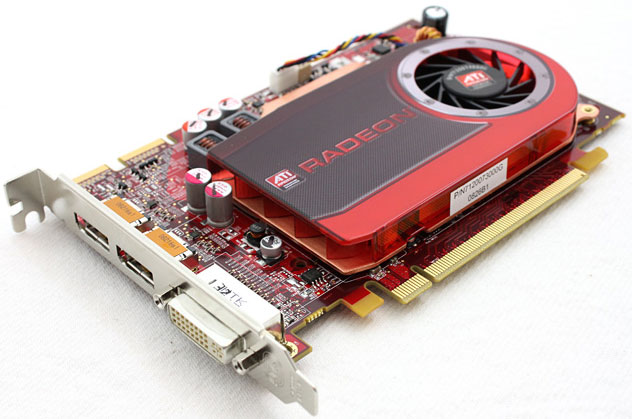Sponsored by AMD ATI Radeon
ADVERTORIAL: ATI Radeon HD 4650/70: Top Value for Bottom Dollar
4650/4670: Visual Quality
As we mentioned earlier, increasingly often users are less concerned with whether a PC can play this or that piece of multimedia and more concerned with what else the PC can do while playing the media. Some of this comes down to guesswork and basic arithmetic. For example, if playing a Blu-ray disc consumes 90% of available CPU resources, you’re stuck. The system is going to play that, only that, and it may not even play the disc well. However, if playing that Blu-ray only consumes 35% of available CPU resources, then you have the ability to tackle another heavy-duty task in the background, such as transcoding videos for your portable player or recording shows from a TV tuner. As a general rule, you don’t want to run a CPU above 70% to 80% of its capacity as fleeting utilization spikes can cause application hiccups, poor system response, or, less often, outright crashes.
For years now, graphics vendors have seen the CPU grow ever more beleaguered and have sought to add value to their products by offloading as much processing load as possible from the CPU to the GPU. This has actually been going on for well over a decade, arguably since the days when MPEG-2 decoding first migrated to dedicated circuitry in the graphics processor. More recently, we see today’s primary high-def codecs (MPEG-2, WMV9, VC-1, and H.264) getting their own dedicated acceleration hardware within the GPU. Before this happened, playback of 1080p video on PCs was nearly impossible as even the best contemporary CPUs simply lacked the horsepower to tackle such a massive task at real-time speeds.
This isn’t to say that HD decoding is the only job GPUs help with. Even before HD came into vogue, plenty of users were using PCs for DVD and streaming video playback. Unfortunately for most consumers, PC-based video from the first half of this decade tended to look pretty shoddy. A lot of the signal processing techniques used in home DVD players had yet to appear in PC playback hardware. So it happened that ATI and others set about implementing and refining features such as adaptive de-interlacing, sharpening, color enhancement, noise reduction, and other post-processing improvements. Collectively, ATI called its approach to these improvements Avivo. In an era before 5 Mb/sec broadband and HD media, such improvements made the difference between night and day in visual quality.
Does that mean that today Avivo is no longer needed? No, quite the opposite. People still need better-looking streaming video and disc playback, and most systems older than three or four years (more recent for integrated graphics-based PCs) are likely to lack technology like Avivo to perform such image enhancements. The moral of the story is that if you watch video on your PC, you’ll enjoy the content a lot more with post-processing technology like Avivo in play.
More recently, ATI updated its approach to Avivo HD, which added HDMI support so that PCs could output straight to HDMI-equipped TVs and amplifiers. (ATI was the first to enable digital video and audio output over a single PC-based HDMI port.) The Unified Video Decoder (UVD) engine sits alongside Avivo HD in modern AMD GPUs, with the latest UVD 2.x updates in the HD 4000 series taking over nearly all of the decoding work for H.264, AVC, and VC-1 video streams. AMD’s implementation also tackles dual-stream decoding so users can enjoy picture-in-picture and full BD-Live support.
In short, if you want to have all of the latest video playback acceleration and enhancement capabilities on your PC, the HD 4650 or 4670 is a very affordable way to do it. The quality difference compared to older hardware will be stunning.
Get Tom's Hardware's best news and in-depth reviews, straight to your inbox.
Tom's Hardware is the leading destination for hardcore computer enthusiasts. We cover everything from processors to 3D printers, single-board computers, SSDs and high-end gaming rigs, empowering readers to make the most of the tech they love, keep up on the latest developments and buy the right gear. Our staff has more than 100 years of combined experience covering news, solving tech problems and reviewing components and systems.
-
mlcloud At least give us the links to some of the 4650/70 benchmarks... Other than that, great read, great recommendations, looking to upgrade my pentium 4, 1.4ghz 256mb (ddr). Was looking at using the HD4200 on the 785g series from AMD, but if I can make a true gaming computer out of it ... hm... tempting.Reply -
I'm waiting for a HIS HD4670 1GB to arrive soon. It even has HDMI output.Reply
Got it really cheap from newegg. It'll do fine with my Intel E5200. Nothing like a super gaming machine, but hope to play TF2 and L4D with good gfx. That's all i play atm.
-
tortnotes Advertorial? How much did AMD pay for this?Reply
Not that it's not good content, but come on. Doesn't Tom's make enough from normal ads? -
duckmanx88 mlcloud Was looking at using the HD4200 on the 785g series from AMD, but if I can make a true gaming computer out of it ... hm... tempting.Reply
on their gaming charts the 4670 is listed. plays FEAR 2 pretty well. i assume it can than handle all Source games as well but at lower resolutions, medium settings, no AA, the usual. -
Assuming I'm assembling a new system and the HD 4650/4670 is the most cost-effective graphics card... what then is the most cost-effective processor to pair with it?Reply
-
Good thing to see ATI marketing their 4650/4670.Reply
I was hoping to see more of their mid-range cards. -
WINTERLORD great article these are some nice cards for the price, i wonder though if you got 2 of them and tried to put them in a crossfire config. since they dont require a power source, other then the pci-e slot, would 2 of them cause any problems drawing all that current through the motherboard? kinda wondering if there would be any impact there.Reply -
Ati making great job. In my office there was need to meka PC with 6 individual monitors. Solution - mainboard asus p5q-e + 3 ati 3650 video cards with vga+DVI outputs. Great working very cheep in cost. Tried to meke the same with nvidia 8400gt - no result 4 monitors individual maximum. Ati - rulezzzReply
-
lien +Reply
Installed an Sapphire 4650 AGP on a backup system in August.
Overclocked it & almost pissed myself on how good the image quality was on that system.
Article confirms....
value based articles are refreshing


